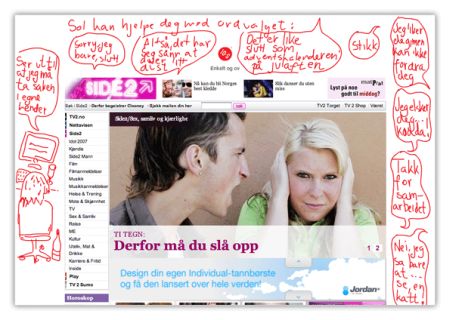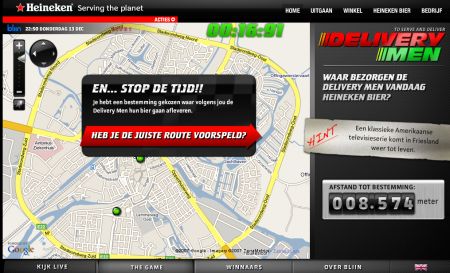von Roland Hachmann | Dez. 20, 2007 | Ad News, Blog, Digital Marketing, Marketing, Online Advertising
This is a rather interesting online advertising approach from Norway:
One of Norways largest online news sources wanted to promote their online services. The idea: several copywriters comment live on the articles on the news portal, during the day and evening hours.

Within around 150 hours, more than 1,000 unique ads have been created this way. Enjoyable idea, and if the live comments by the copywriters were any good, people might have actually surfed the portal for quite some time just to read the ads…
von Roland Hachmann | Dez. 18, 2007 | Blog, Digital Culture, Marketing, Social Media Marketing
At the Church of the customer Blog, there is an approach of how to categorize communities, which I found quite interesting. The build a square, one axis being size, the other being devotion. Most communities can be aligned along these axes:
- Little Devotion, little in size: Clique, like a small world. (Anyone who can invite me?)
- Little in size, but high in devotion: Cult, like Maker’s Mark Ambassadors. (Never heard of them!)
- Low in devotion but large in size: Network, like LinkedIn or Xing.
- Large in size and high in devotion: Nation, like Netroots Nation. (Never heard of them either!)
So what does that tell us? Size and devotion are the two main things affecting any community. Question is, whether it is possible to increase both at the same time, or if it is better to focus on one at a time?
von Roland Hachmann | Dez. 17, 2007 | Ad News, Blog, Digital Marketing, Marketing, Mobile Marketing, Online Advertising
Heineken in the Netherlands has launched a new advergame which looks interesting. The game asks playes to spot and track the delivery men of Heineken around the Netherlands and find out what their next stop will be. Whoever guesses correctly first, gets the chance to win a Nokia phone. So in a way, this game play is not that complicated or creative.

What I admire, is something completely different: Apparantly, these delivery men are tracked in real time with real journey data, during the regular working hours. And this is remarkable. I have also worked for clients with a huge fleet of delivery vehicles and I do appreciate the fact that Heineken managed to include their drivers into this game. Creatives usually come up easily with lots of brilliant ideas how to connect the mobile workforce of a client with a webpage via all sorts of mobile devices like phones or GPS tracking devices. But organisational reality most of the time kills these ideas.
So this won’t have been easy to push through the internal, most likely rather political, approval and commitment chain in order to get the buy in of all the different departments (marketing, distribution, logistics, etc.). Kudos, I like that.
(via)
von Roland Hachmann | Dez. 4, 2007 | Ad News, Blog, Digital Marketing, Marketing, Online Advertising
Mitch Joel blogs about advertising campaigns where the traditional campaign is long gone, but there still is a digital trail on YouTube and the likes, now leading to no longer existing microsites, etc.
In a traditional ad campaign, Marketers could get in and out in the span of a couple of weeks. Times have changed. The length of an ad campaign in the Digital Marketing space is dictated by the audience not by when the ad spend dies.
Interesting thought that has sparked a debate about purchasing the (digital) rights to media assets of integrated marketing campaigns. Here is my two cents which I put into Mitch’s comments:
Purchasing the rights to actors, directors, photography and such really depends on negotiations. I remember from my own experience that the guys at the classical advertising department were always shocked when they had to buy the rights for the internet, too. Because all of a sudden, they didn’t just buy the rights for, say, 1 year in Germany (in this case), but for world wide, because that is what the internet is: a medium that is globally accessible. It made each campaign relatively more expensive all of a sudden.
Just imagine what it will be like if they have to buy the rights not for Germany, and not for one year, but for worldwide, for ever!!
Advertisers won’t be able to not buy the digital rights. So the conclusion will have to be either: better rates in the contracts, or second rate actors, directors and photography. Not the most ideal setup.
von Roland Hachmann | Nov. 30, 2007 | Ad News, Blog, Digital Marketing, Marketing, Social Media Marketing
There is an interesting short post at one of the NY Times blogs about the evolution of beacon, Facebooks new project to include behaviour on third party sites within the news feed and profile. They show different types of popups of how Facebook alerted their users in a more or less obvious fashion about including third party information on their feed.
It started with a popup merely stating the fact, that the information will be passed on. Not reacting to it was assumed as approval. It disappeared after a short while and if you missed it, you „approved“ of the information transfer. Later versions included opt-outs, opt-ins, etc.
Facebook executives tell reporters that users who ignore the alert boxes will no longer be considered to have said “yes,†even after two days. If users ignore the alert box, Facebook says it will not post the news of their purchases to their friends. This is a big change, if implemented correctly. Users will still be hassled by the alert boxes from Facebook on its partner sites, but ideally they can ignore them now and not worry about their purchases being shared.
Facebook executives say they do not want to add a universal opt-out button because then users would not be able to try out Beacon on different sites to see what it can offer. One Facebook executive predicts that consumers may “fall in love†with Beacon once they understand it. Only time will tell.
A very broad prediction, which I don’t believe. But we’ll see.
It’s amazing that facebook started with such an opt-out clause – including the fact that you only had a few seconds to opt-out until the popup would disappear. Now I know that in the US, opt-out is legally viable, which it isn’t in Germany. Here in Germany, nobody would have even considered opt-out in the first place.
But that doesn’t make it an „American approach“ per se. I think, it rather looks like an amateurish approach to treat users in that way and I am not surprised that they changed it to the later versions. I would have assumed that they start with the opt-in approach right away, thinking user-centric instead of brand-centric. But hey.



 Wo ich sonst so bin...
Wo ich sonst so bin...